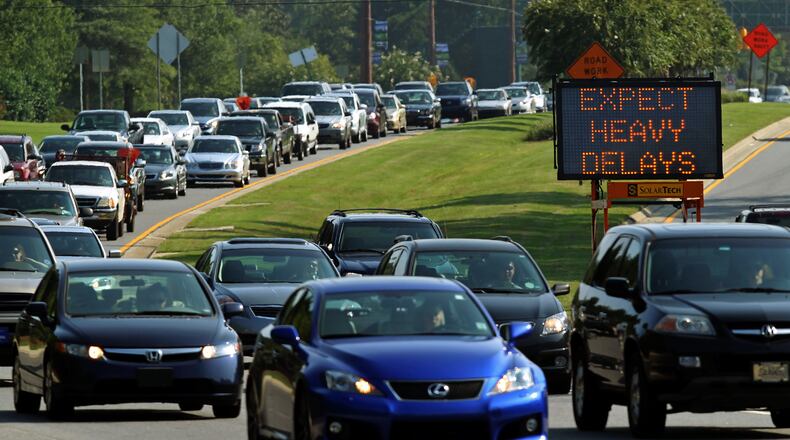Researcher Bartley Danielsen studies how charter schools, voucher programs and education savings accounts impact property values and family residential choice.
Danielsen is the president and founder of Environmentalists for Effective Education and a visiting professor at Kennesaw State University. He is an associate professor of finance and real estate at North Carolina State University.
In this essay, Danielsen contends metro Atlanta’s traffic woes come in part from families fleeing intown areas for the suburbs in search of better schools. The exodus of families creates traffic jams that would be mitigated if parents didn’t have to move farther from their jobs for better schools.
His solution: School choice for all residents of low-income areas.
By Bartley R. Danielsen
During President Trump’s State of the Union address last week, he called on Congress to adopt a school choice program to give a million students a chance to attend a school other than the one assigned to them by their address.
The vast majority of students seeking school choice in our country – including metro Atlanta -- live in struggling neighborhoods where many families have abandoned public schools for better ones in the suburbs.
Many of their peers and their families long ago took dramatic steps to move to communities with the finest public schools. Parents make the sacrifice to commute to jobs far away.
That is creating a great environmental challenge as urban sprawl eats up greenspace, creates more pollution and contributes to endless hours of traffic congestion – something that is an everyday occurrence in metro Atlanta.
In low-income neighborhoods, crime, poverty and depressed housing values are the norm as a school is the most important anchor of success in a community.
If we want to revitalize neighborhoods and attract a more diverse population to low-income, inner city neighborhoods and other depressed areas where there are failing schools, we should consider a new model that embraces school choice as an environmental and economic policy and not just as an education reform option.
Neighborhood Hope Scholarships are a new K-12 idea that would enable all families that live in low-income neighborhoods to send their child to the public or private school of their choice. Under Neighborhood Hope Scholarships, the General Assembly would allocate state tax dollars to follow the child.
If there was no room at a public school to exercise public school choice, parents could also use the money as a scholarship to a private school. And with so many children eligible for scholarships, new private schools are certain to be created that would be the anchor of revitalization of these communities.
This concept should attract support from Democrats and Republicans alike as it is an effective economic development and environmental policy for low-income communities across the state.
If you don’t believe that young families leave the inner city for better schools in the suburbs, consider these numbers:
In the United States, there are about the same number of newborns to age 4 as there are children age 5 to 9. However, in the area covered by the Atlanta Public Schools district, there are 15% fewer children who are 5 to 9-years-old than younger children. These school-aged kids have fled to better schools elsewhere.
During the 2020-21 school year, Forsyth County Schools will have more students than Atlanta Public Schools even though Forsyth has half the population of Atlanta. There are 22% more children age 5 to 9 than newborns to age 4 living in Forsyth. The schools are obviously attracting families with school-aged kids.
For a Cumming resident, it can take 90 minutes to drive to downtown Atlanta to get to work during rush hour. That’s a lot of time in traffic, away from the family and generating carbon dioxide.
There is no doubt many of these families who left neighborhoods with marginal schools would have preferred to stay if they had a more acceptable option. To make that happen, we have to provide families of all income levels school choice. That means allowing them to access their own tax dollars to transfer to a public or private school that can accommodate their children.
With the Neighborhood Hope program in place, financially secure families would no longer feel compelled to move away, leaving the poor behind. With better school options in previously struggling neighborhoods, crime would drop, and property values would increase.
According to a 2015 research paper in the Journal of Real Estate Literature, school choice programs across the globe have created double-digit percentage increases in property values because new educational options make neighborhoods more desirable. Just look at how Drew Charter School has revitalized East Lake and the surrounding community in East Atlanta, making it a more desirable place to live.
Offering Neighborhood Hope Scholarships to revitalize low-income areas in our state would create better schools for our children and at the same time protect our environment, combat the challenges of traffic congestion and rebuild communities.
About the Author
Keep Reading
The Latest
Featured


